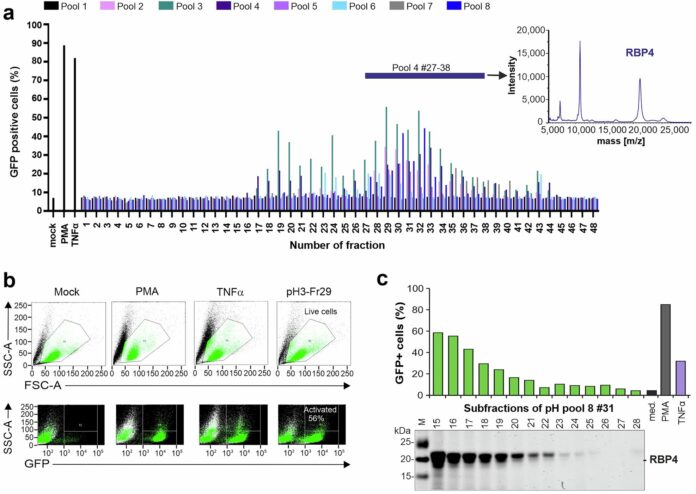An international research team led by a University of Ottawa Faculty of Medicine investigator has revealed ultra-detailed intricacies in how nerve signals activate at the neuromuscular junction, a specialized synapse that connects motor neurons to skeletal muscle fibers.
The team’s discovery offers a novel look at how neuromuscular signals are communicated on the millisecond time scale, findings that could have wide-reaching implications for our understanding of the interplay between nerves and muscle throughout the body. This new knowledge could also potentially help scientists design drugs for a group of muscle-weakening conditions resulting from disease-causing mutations.
In research published in Science, the collaborative team led by uOttawa Faculty of Medicine professor Dr. John Baenziger used cutting-edge single-molecule techniques to capture several atomic resolution structures of a neurotransmitter receptor along its activation pathway.
Solving a structural puzzle
Ultimately, the collaborators ended up capturing a missing link—an intermediate “primed” state that helps define communication between nerves and muscles.
“This new intermediate structure, called a primed state, is extremely important because it plays a critical role in shaping neuromuscular communication,” says Dr. Baenziger, senior author of the newly published paper. “Our study provides the first glimpse into this key intermediate along the activation pathway—in particular, the step called priming.”
Dr. Baenziger says that as similar protein receptors are found in the brain, this “new insight impacts broadly on our understanding of communication at neuronal synapses.”
Challenging long-held assumptions
The innovative new study and its atomic-level insights dispel a scientific myth that’s been assumed for decades, according to Dr. Baenziger.
He explains that for well over 50 years, it’s been assumed that these protein receptors are activated by a phenomenon called concerted conformational transition. In this protein-changing event, all parts of the protein were understood to move together synchronously, leading to a final activated state. The concerted conformational transition framework has ultimately been used to try to understand how disease-causing mutations or different drugs modulate function.
But in this major research publication, the team reveals this is “absolutely not true,” Dr. Baenziger says.
Their research reveals that in fact, individual components of the protein receptor move asynchronously—meaning some parts move first while others move later.
“This information will be critical to understanding how disease-causing mutations and different drugs modulate neuromuscular communication—information that should ultimately lead to better drugs to treat congenital myasthenic syndrome and other diseases resulting from impaired synaptic communication.”
Research team’s next steps
Dr. Baenziger’s dynamic lab at the uOttawa Faculty of Medicine is focused on understanding how a protein neurotransmitter receptor, the nicotinic acetylcholine receptor (nAChR), shapes communication at the neuromuscular junction. This receptor is an important member of a family of proteins that has been studied widely, in large part because understanding its function can help unlock treatment paths for neurological and neurodegenerative disorders.
Now, armed with this new study’s findings, he and the collaborative team hope to fully understand how nAChR function is influenced in the context of this model of activation. The research team will seek to solve the structures of these receptors that harbor disease-causing mutations and gauge how they react in the presence of different drugs.
“We will want to use these new structures as templates to design better therapeutics,” says Dr. Baenziger, a full professor in the Faculty’s Department of Biochemistry, Microbiology and Immunology.
The new structures were solved by first author Dr. Mackenzie Thompson, who until recently was a Ph.D. student in Dr. Baenziger’s lab and who is now a post-doctoral researcher at University of California, Berkeley.
The team also included close coordination with Drs. Hugues Nury and Elefterios Zarkadas, both at the Institute of Structural Biology—a research institution in Grenoble, France, where Dr. Baenziger has cultivated fruitful collaborations. uOttawa’s Dr. Corrie daCosta in the Faculty of Science also played a major role, bringing sophisticated single-molecule functional experiments into the study.
More information:
Mackenzie J. Thompson et al, Asynchronous subunit transitions prime acetylcholine receptor activation, Science (2025). DOI: 10.1126/science.adw1264
University of Ottawa
Citation:
Discovery of ‘primed’ state in neuromuscular receptors may guide future drug design (2025, October 16)
retrieved 17 October 2025
from https://medicalxpress.com/news/2025-10-discovery-primed-state-neuromuscular-receptors.html
This document is subject to copyright. Apart from any fair dealing for the purpose of private study or research, no
part may be reproduced without the written permission. The content is provided for information purposes only.


